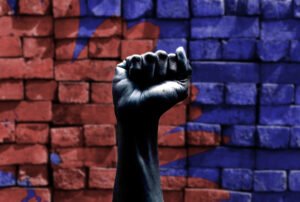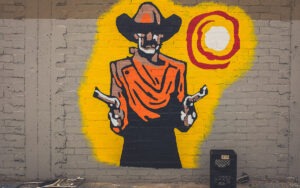
August 12, 2019; PBS NewsHour and NBC News
According to the Pew Research Center, as of 2017, 44.4 million people in the US, or 13.6 percent of the population are foreign born, of whom roughly 50 percent are from Latin America. This is the highest percentage of immigrants in the US since the early twentieth century, when the percentage of foreign-born residents peaked at just under 15 percent.
NPQ has regularly covered the attacks facing immigrants. In June, we noted that, “Whether the means involve border walls, travel bans, separating parents from children, cuts to refugee and asylum admissions, restricted access to federal benefits, rules permitting indefinite detention, or efforts to add a citizenship question to the census, the hostility to immigrants and people of color has been consistent throughout.”
But now the hostility, especially for the nation’s burgeoning Latinx population—both first-generation immigrant and Native-born—has hit another level. As Associated Press journalists Russell Contreras and Anita Snow, reporting for PBS NewsHour, explain, the shootings in El Paso, Texas and Gilroy, California—along with a “huge immigration raid of Mississippi poultry plants last week that rounded up 680 mostly [Latinx] workers”— have amped anxiety levels.
“It’s almost like we’re hitting a climax of some kind,” Jennifer Garcia, a 23-year-old college student from Mexico tells the NewsHour team. “Some people, especially our elders, don’t even want to leave the house or speak Spanish.”
Alexandro Jose Gradilla, a professor of Chicana and Chicano studies at California State University, Fullerton, notes that he is at risk every time he stands in front of a classroom. “White supremacists don’t see the difference between immigrants to fourth-generation [Latinxs]. They see brown.”
Sign up for our free newsletters
Subscribe to NPQ's newsletters to have our top stories delivered directly to your inbox.
By signing up, you agree to our privacy policy and terms of use, and to receive messages from NPQ and our partners.
Carlos Galindo-Elvira of the Anti-Defamation League in Arizona tells Contreras and Snow, “What I tell people is that we cannot live in fear, but we also have to be vigilant and be aware of the rhetoric and our surroundings.” Michelle Otero, poet laureate of Albuquerque, says of the El Paso shooter, “This is someone who drove nine hours to kill people like me. I don’t know what to make of that.” Otero has responded by helping organize a public reading by poets in Albuquerque that aims to raise money for the families of those who perished in El Paso.
It is notable that the attacks coincide with a period in which the US Latinx population is gaining “economic, social, and political clout,” notes Nicole Acevedo of NBC News. Stacie de Armas, vice president of strategic initiatives and consumer engagement at Nielsen, tells Acevedo about the results from a study the Nielsen ratings firm just completed. Among the findings:
- Latinx purchasing power is expected to top $1.9 trillion by 2023.
- Latinxs have a median age of 28, compared to 38 in the general population, and account for 75 percent of all US labor force growth over the last six years.
- About 60 million Latinx persons live in the US today. That number is projected to increase to 109 million by 2058.
- Latinx voter turnout reached 11.7 million in 2018, up from 6.8 million in 2014—a 4.9 million increase. The increase in voter rolls between 2014 and 2018 is so large that it exceeds the increase in Latinx voters in the previous two dozen years (3.9 million increase).
It may seem paradoxical that increased Latinx community prosperity and political participation has spurred on animosity. But the backlash in large measure is a product of Latinx growth and success. White supremacists in their language call attention to rising Latinx numbers, albeit in completely absurd terms. For example, the El Paso shooter in the manifesto he posted claimed he was acting in response to a “Hispanic invasion [sic].”
At a policy level, a recent Syracuse study illustrates one aspect of the political assault that Latinxs face. According to that study, 120,000 worker deportations have taken place nationally due to raids since April 2018, even as only 11 people have been charged for hiring those workers. The Mississippi raid of 680 workers, which, as Adrian Carrasquillo in New Republic wrote, left “children sobbing and wives tearfully saying goodbye to husbands through chain-link fences as authorities processed workers” was hardly an isolated incident.
On a personal level, some Latinxs have responded by calling out those who assail them. For example, Contreras and Snow interviewed Xiara Mercado, a US Air Force senior airman. When a woman at a coffee shop told Mercado that her speaking Spanish was “distasteful” and “does not represent America and that uniform you are wearing,” Mercado replied, “The only distasteful thing here is that you are clueless to your discrimination, please educate yourself. Have a nice day.”—Steve Dubb













